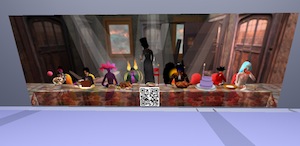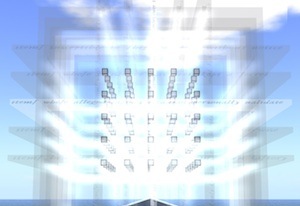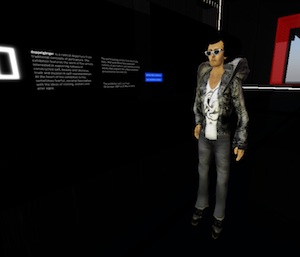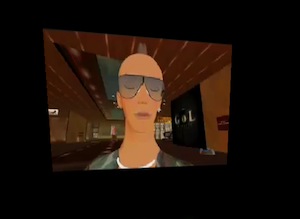There hasn’t been an enormous fanfare about the launch of the National Portrait Gallery’s doppelganger exhibition in Second Life, but there probably deserves to be. For its first foray into virtual worlds, the Gallery has created an impressive exhibition that beautifully showcases the power of digital artwork.
I asked the architect of the exhibition, Greg More (SL: Dynamo Zanetti) to explain each of the exhibits, which he kindly agreed to do. Greg is a Senior Lecturer in the School of Architecture and Design at RMIT. Since 2002 he’s been primarily engaged in the use of 3D, realtime environments for architecture design visualisation. The RMIT’s island in SL, for RMIT architecture and interior design students, came into existence in early 2007. Greg also happens to be the driving force behind OOM Creative, a local virtual worlds design consultancy
Artist: Cao Fei
It seems natural for an exhibition like this to feature machinima, and it’s certainly a striking one that is being shown. Superficially, it’s a montage of Second Life residents’ faces, but the overall effect is much greater.
Greg: “Developed for the Venice Bienale 2007, this is the only work in the show that wasn’t developed specifically for Portrait Island. Space designed to envelope the viewer into a screen experience, and also marks the limits of the landparcel supporting the streaming video.”
 Artist: Patrick Lichty
Artist: Patrick Lichty
Aside from the vivid ‘Last Supper’ portrait, which is alone worth a visit, there are also QR codes for each of the portrait subjects, readable by smart phones with the appropriate software installed.
In CodePortraits we can extract these representations from their native environment via Quick Response codes which enable us to watch his archive of footage on our own mobile devices. Viewing these videos on a portable device, that can be played anywhere, at any time, reminds us of the photographs of loved ones and family that we may keep in our wallets, or the earlier tradition of the cameo.
Another fascinating mix of digital media with more traditional imagery.
temporary self portrait in preparation for the singularity
 Artist: Andrew Burrell.
Artist: Andrew Burrell.
The largest work in the exhibition, it’s difficult to provide an explanation of its scope and purpose that’s better than the one provided by the artist himself. In short, the exhibit is a virtual device offering a glimpse of the narratives of the artist’s life, “both remembered and imagined”:
Each of the cubic nodes within the device can forge new connections with its neighbours creating a navigable network of narratives to which the viewer is given access through text and image. The work questions the site of the self and its relationship to the narratives of memory.
 Artists: Adam Nash, Christopher Dodds and Justin Clemens
Artists: Adam Nash, Christopher Dodds and Justin Clemens
I have to admit this was probably the exhibit that fascinated me the most. The Autoscopia website explains it nicely, but essentially you enter a phrase such as your Second Life name, and you receive (after a wait) a link to a detailed profile of yourself as found on the internet more widely. Try it for yourself and you’ll likely be surprised with the results.
Autoscopia’s portraits are built using data from internet-based ‘vanity searches’ conducted within the Second Life installation. Each name creates a unique outcome composed of 27 ‘limbs’. Each limb is fed data from websites such as Google, Facebook, Twitter etc, with colours, geometry and audio affected by variations in search volume. Data is then re-published via discrete web pages automatically composed through snippets of text and images collected during the search
 Artist: Gazira Babeli
Artist: Gazira Babeli
The experience of entering iGods can be a little disconcerting. The Greek temple exterior contrasts against the impressive experience of having your avatar transposed onto one of the seven ‘sins’ on the inside:
Move a little closer and the clones come to life, morphing into the appearance of the observer’s avatar; replicating their image back at them. Gaz’s hall of mirrors reminds us that, in Second Life, DNA is code and in virtual worlds this code can be replicated or borrowed. This unnerving experience exposes fears associated with identity theft and the often reluctant realisation of personal identification with one’s avatar.
The Wrap
According to Greg, the main approach for the exhibition, and the build, is not to replicate existing notions of portraiture or exhibition space. “Gill Raymond, the curator, set a really open brief for the project, and luckily on my advice we developed the space over a couple of phases, allowing for the environment to evolve, accomodate the artists developing the work, and tie things together with the website content”.
Feedback from visitors to date has apparently been enthusiastic, with a significant cohort of visitors spending more than an hour interacting with the exhibits. Kudos to the National Portrait Gallery for their investment in the exhibition. Alongside the ACVA initiative and the momentum built by the University of Western Australia’s Art competitions in Second Life, it’s fair to say that Australian art in the virtual world is an incredibly lively part of the wider art community.


[…] Hide in Plain SightWhat are people saying? -<blog> National Portrait Gallery in Second Life: http://bit.ly/66YvFH #secondlife #arti`m amazed that people still use #secondlifeJoe Triskaidekaphobia moved to IBM […]